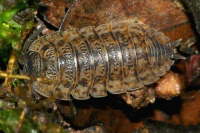Phylum Arthropoda (Arthropods) ➔ Subphylum Crustacea (Crustaceans) ➔ Class Malacostraca (Malacostracans) ➔ Order Isopoda (Pillbugs, sowbugs, woodlice) ➔ Family Trachelipodidae
Trachelipus rathkii (Brandt, 1833)
Synonyms and other combinations:
Porcellio affinis C. Koch, 1841 | Porcellio confluens C. Koch, 1841 | Porcellio ochraceus C. Koch, 1841 | Porcellio parietinus L. Koch, 1901 | Porcellio rathkii Brandt, 1833 | Porcellio striatus Schnitzler, 1853 | Porcellio sylvestris C. Koch, 1838 | Porcellio taeniatus Schoebl, 1861 | Porcellio tetramoerus Schnitzler, 1853 | Porcellio trilineatus C. Koch, 1841 | Porcellio trivittatus Lereboullet, 1853 | Porcellio varius C. Koch, 1841 | Trachelipus pleonglandulatus Radu, 1950 |
Distribution:
Europe, North America, South America.Habitat:
Open ground: waterside with rich vegetation; fens; grassland with herbs; farmland, bare soil; forest edges; rarely in deciduous forests.Habitus:
Body with lateral, longitudinal dorsal rows of bright patches, usually with median band, anterior tergits with dense, posterior ones with less dense tubercles; eyes consisting of 21 - 23 ommatidia (single eyes of which the compound eyes are composed).Females: size up to 11 mm, nearly always more or less ferrugineously spotted.
Males: size 7.5 to 12 mm, body narrower, darker in color than in females and without ferrugineous spots.
Biology:
Trachelipus rathkii is a species of open grounds that is less photophobic compared to other native species. It prefers dry-warm locations. The woodlice feed mainly on decaying plant material, but also feed algae, fungal tissues, dead insects and feces.Annotation:
As a result of studies in post-mining areas, Trachelipus rathkii was found to be by far the most abundant species of woodlice found in all biotope types. Woodlice are the most important saprophages in these areas, which promote soil formation through foliage decomposition and microbial distribution and thus create the conditions for the colonisation of other animals and plants.References, further reading, links:
- Boyko C.B, Bruce N.L., Merrin K. L., Ota Y., Poore G.C.B., Taiti S., Schotte M. & Wilson G.D.F. (Eds) (2008 onwards). (2018). WoRMS Isopoda: World Marine, Freshwater and Terrestrial Isopod Crustaceans database (version 2017-03-01). In: Species 2000 & ITIS Catalogue of Life, 2017 Annual Checklist (Roskov Y., Abucay L., Orrell T., Nicolson D., Bailly N., Kirk P.M., Bourgoin T., DeWalt R.E., Decock W., De Wever A., Nieukerken E. van, Zarucchi J., Penev L., eds.). Digital resource at www.catalogueoflife.org/annual-checklist/2017. Species 2000: Naturalis, Leiden, the Netherlands. ISSN 2405-884X.
- Schmidt, Christian: Revision of the European species of the genus Trachelipus Budde-Lund, 1908 (Crustacea: Isopoda: Oniscidea), Zoological Journal of the Linnean Society (1997), 121: 129-244.
- Bergmann, S.; Witsack, W.: Zur Arthropodenfauna von Tagebaufolgelandschaften Sachsen-Anhalts 1. Landasseln (Oniscoidea, Isopoda, Crustacea)- Hercynia N. F. 34 (2001): 261-283, ISSN 0018-0637.
